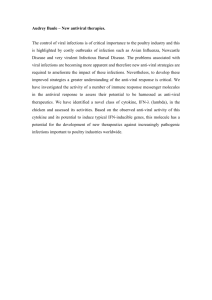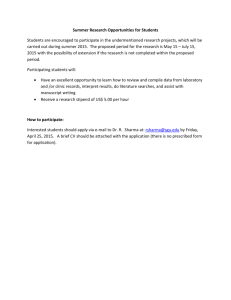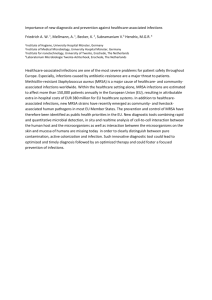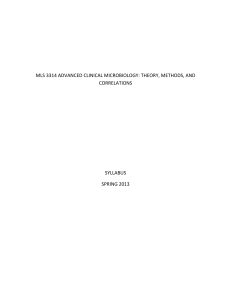microbiology program – medical facylty, 2 semester 2013/2014
advertisement
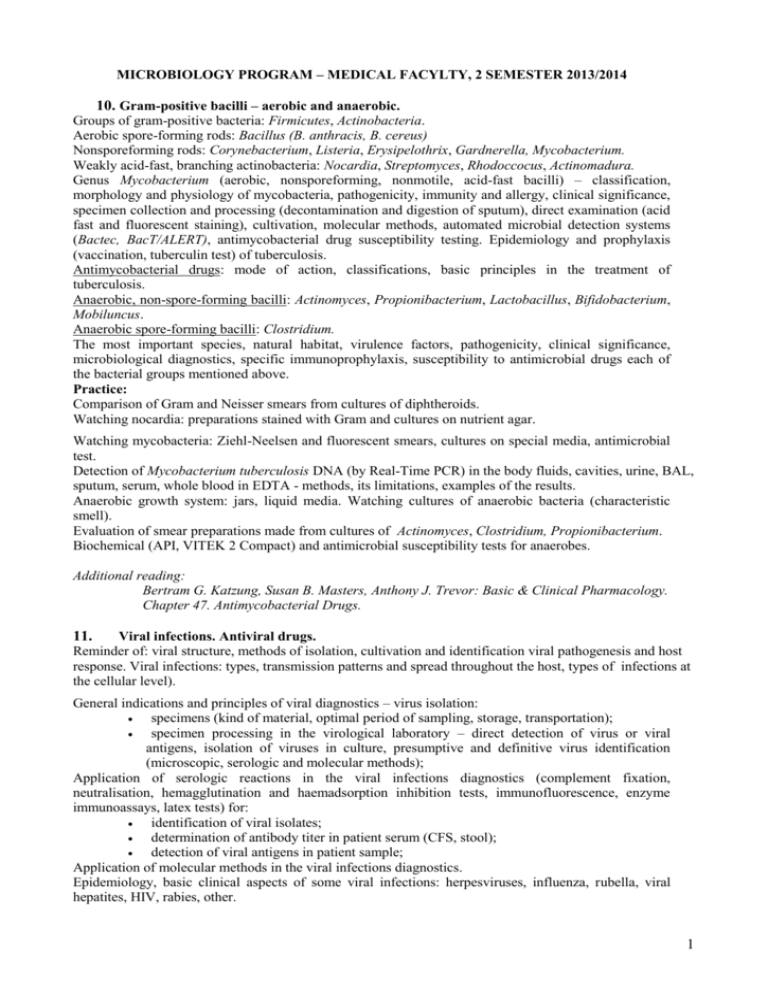
MICROBIOLOGY PROGRAM – MEDICAL FACYLTY, 2 SEMESTER 2013/2014 10. Gram-positive bacilli – aerobic and anaerobic. Groups of gram-positive bacteria: Firmicutes, Actinobacteria. Aerobic spore-forming rods: Bacillus (B. anthracis, B. cereus) Nonsporeforming rods: Corynebacterium, Listeria, Erysipelothrix, Gardnerella, Mycobacterium. Weakly acid-fast, branching actinobacteria: Nocardia, Streptomyces, Rhodoccocus, Actinomadura. Genus Mycobacterium (aerobic, nonsporeforming, nonmotile, acid-fast bacilli) – classification, morphology and physiology of mycobacteria, pathogenicity, immunity and allergy, clinical significance, specimen collection and processing (decontamination and digestion of sputum), direct examination (acid fast and fluorescent staining), cultivation, molecular methods, automated microbial detection systems (Bactec, BacT/ALERT), antimycobacterial drug susceptibility testing. Epidemiology and prophylaxis (vaccination, tuberculin test) of tuberculosis. Antimycobacterial drugs: mode of action, classifications, basic principles in the treatment of tuberculosis. Anaerobic, non-spore-forming bacilli: Actinomyces, Propionibacterium, Lactobacillus, Bifidobacterium, Mobiluncus. Anaerobic spore-forming bacilli: Clostridium. The most important species, natural habitat, virulence factors, pathogenicity, clinical significance, microbiological diagnostics, specific immunoprophylaxis, susceptibility to antimicrobial drugs each of the bacterial groups mentioned above. Practice: Comparison of Gram and Neisser smears from cultures of diphtheroids. Watching nocardia: preparations stained with Gram and cultures on nutrient agar. Watching mycobacteria: Ziehl-Neelsen and fluorescent smears, cultures on special media, antimicrobial test. Detection of Mycobacterium tuberculosis DNA (by Real-Time PCR) in the body fluids, cavities, urine, BAL, sputum, serum, whole blood in EDTA - methods, its limitations, examples of the results. Anaerobic growth system: jars, liquid media. Watching cultures of anaerobic bacteria (characteristic smell). Evaluation of smear preparations made from cultures of Actinomyces, Clostridium, Propionibacterium. Biochemical (API, VITEK 2 Compact) and antimicrobial susceptibility tests for anaerobes. Additional reading: Bertram G. Katzung, Susan B. Masters, Anthony J. Trevor: Basic & Clinical Pharmacology. Chapter 47. Antimycobacterial Drugs. 11. Viral infections. Antiviral drugs. Reminder of: viral structure, methods of isolation, cultivation and identification viral pathogenesis and host response. Viral infections: types, transmission patterns and spread throughout the host, types of infections at the cellular level). General indications and principles of viral diagnostics – virus isolation: specimens (kind of material, optimal period of sampling, storage, transportation); specimen processing in the virological laboratory – direct detection of virus or viral antigens, isolation of viruses in culture, presumptive and definitive virus identification (microscopic, serologic and molecular methods); Application of serologic reactions in the viral infections diagnostics (complement fixation, neutralisation, hemagglutination and haemadsorption inhibition tests, immunofluorescence, enzyme immunoassays, latex tests) for: identification of viral isolates; determination of antibody titer in patient serum (CFS, stool); detection of viral antigens in patient sample; Application of molecular methods in the viral infections diagnostics. Epidemiology, basic clinical aspects of some viral infections: herpesviruses, influenza, rubella, viral hepatites, HIV, rabies, other. 1 Antiviral drugs: groups of medicines with their main representatives, mode of action, spectrum of antiviral activity, application, side effects. Antiviral susceptibility testing. HAART ( the desired results and side effects). Prion diseases. Practice: Detection of rabies virus antigens by DIF method. Detection of antigens or specific antibodies in viral infections – IF, Elisa tests. Presentation in the laboratory: determination of BK virus and cytomegalovirus DNA by Real-Time PCR in serum, quantitative determination of antibodies against Epstein-Barr virus (IgM and IgG class) by Luminex Map - examples of results and interpretation. Additional reading: Bertram G. Katzung, Susan B. Masters, Anthony J. Trevor: Basic & Clinical Pharmacology. Chapter 49. Antiviral Agents. 12. Fungal infections Reminder of fungi morphology and reproduction. Practical classification of fungi: dermatophytes, yeasts, filamentous fungi, dimorphic fungi. Occurrence of fungi in the environment and in the normal human flora. Fungal diseases: infections, mycotoxicoses, allergic reactions, clinical features and relationships. Host response in fungal infections. Factors influencing the occurrence of mycoses. Infections caused by Candida sp., Cryptococcus neoformans, Geotrichum candidum, Malassezia furfur, Aspergillus sp., Penicillium sp. and dimorphic fungi. General scheme of mycologic investigation: direct smears, detection of antigen, cultures, colonial morphology, biochemical activity, detection of antibody in serum, skin tests. Antifungal agents: groups of medicines with their main representatives, mode of action, spectrum of antifungal activity, application, side effects. Antifungal susceptibility testing. Practice: Evaluation of fungal morphology in KOH, Gram – stained smears. Evaluation of colonial morphology on Sabouraud agar. Evaluation of direct smears from sputum and vagina. Examination of germ tube test – Candida albicans. Examination of biochemical tests. Antifungal susceptibility testing - semi-quantitative method Candifast, R14 Micronaut system (used in severe systemic mycosis), E - tests. Detection of soluble antigens of Aspergillus and Candida in the patient's serum by ELISA - examples of results, clinical significance. Determination of the DNA of Aspergillus and Pneumocystis jirovecii by RealTime PCR in BAL, sputum, bronchial lavage - clinical significance, exemplary results. Additional reading: Bertram G. Katzung, Susan B. Masters, Anthony J. Trevor: Basic & Clinical Pharmacology. Chapter 48. Antifungal Agents. 13. Respiratory tract and the eye infections Reminder of the normal flora and immunity of respiratory tract. Most common URT (upper respiratory tract) and LRT (lower respiratory tract) infections, clinical forms, aetiological agents (viruses, bacteria – streptococci, staphylococci, Haemophilus influenzae, Bordetella pertussis, Mycoplasma pneumoniae, Legionella pneumophila, Chlamydia pneumoniae and Chlamydia trachomatis, Coxiella burnetii, Corynebacterium diphtheriae, mycobacteria, Gram-negative rods, fungi). Community and hospital - acquired infections. Principles of diagnosis (swabs, sputum, BAL, aspirates, microscopic examination, cultures, identification of pathogens, serological tests) and treatment. Infections of the eye: causative organisms, specimens, diagnostics, treatment. Practice: Evaluation of direct smears from sputum. 2 Evaluation of different cultures from throat, ear, sinuses, eye, sputum, discussion about identification of bacteria. Examination and interpretation of antimicrobial susceptibility tests. Detection of Legionella pneumophila and Streptococcus pneumoniae antigen in urine ( e. g. BinaxNOW test) - demonstration of positive and negative result, clinical significance. Streptococcus pyogenes antigen detection (e. g. QuickVue+® Strep A test) in material from a patient (a swab from the throat, pus from tonsills, wounds, skin lesions, etc.) - clinical significance. Determination of RSV mRNA by RT-PCR in BAL, the patient's serum - the application of the test, examples of the results. 14. Diarrhoeal diseases, food poisonings. Reminder of the gastrointestinal normal flora and immunity. Epidemiology, clinical features (vomiting, diarrhoea, enteric fever, toxic food poisoning), causative organisms (bacteria, viruses, protozoa), diagnosis, identification, treatment. Microbiological investigations in gastrointestinal tract infectious diseases: examination of faeces and rectal swabs: isolation on MacConkey and selective media, biochemical and serological tests, phage typing; cultures of blood, faeces, urine, bile, serological tests (Widal test) – typhoid and paratyphoid fever; detection of toxins – Clostridium botulinum, Clostridium difficile, Staphylococcus aureus; detection of Rotavirus antigen in stool; Prophylaxis of enteric infections, carrier state detection, control of water. Practice: Application of selective media in bacteriological stool examination. Evaluation of positive cultures for salmonellae. Evaluation of biochemical tests. Serological typing of salmonellae, shigellae, E. coli. Examination of Widal test. Detection of rota- and adenoviruses antigens in faeces - test VIKIA® Rota-Adeno. Examination of water contamination. Isolation of C. difficile and detection of its toxins. Detection of Helicobacter pylori antigen in stool (ImmunoCard STAT! HpSA test)- clinical importance. Determination of IgG antibodies to Helicobacter pylori by IF and Western blot test. Presentation and discussion of the results 15. Urinary tract infections Reminder of normal flora and immunity of urinary and genital tract. Factors predisposing urinary tract infections, clinical forms, causative organisms. Bacteriological diagnostics of urine: sampling, transport, cultures (quantitative and qualitative evaluation), biochemical identification, antibacterial susceptibility tests. Different pictures of vagina smears – physiology and pathology. The most common infections of female genital tract: candidiasis, trichomoniasis, bacterial vaginosis (Gardnerella vaginalis), chlamydiosis (Chlamydia trachomatis), genital herpes (Herpes simplex virus 2) – examination of vaginal discharge, diagnosis, treatment. Intrauterine and perinatal infections: TORCH (Toxoplasma gondii, Rubella virus, CMV, HSV), Treponema pallidum, Streptococcus agalactiae. Practice: Inoculation of urine. Quantitative and qualitative evaluation of urine cultures. Examination of antibacterial susceptibility tests from urine (record and interpretation). Examination of different direct vaginal smears and cultures (Lactobacillus, Gardnerella vaginalis, Streptococcus agalactiae). 3 An example of rapid diagnostics - detection the presence of Streptococcus agalactiae by Real-Time PCR in specimen - demonstration and discussion of the test. Determination of Chlamydia trachomatis DNA in cervical and vaginal swabs, BAL from newborns - the application of the test, examples of results 16. Sexually transmitted diseases (STD) Currently important aetiological agents of sexually transmitted diseases: Treponema pallidum, Neisseria gonorrhoeae, Chlamydia trachomatis, Trichomonas vaginalis, Candida albicans, Gardnerella vaginalis, Papilloma virus, Herpes simplex virus 2, HIV, HBV, HCV, Haemophilus ducreyi. Syphilis (lues): morphology and physiology of treponemas (Treponema pallidum, T. pertenue, T. carateum, saprophytic treponemas); immunity and clinical forms of treponemas infections; diagnostics depending on disease period: direct smear, nonspecific (flocculation, complement fixation) and specific serologic tests (FTA–ABS, TPHA, TPI); Gonorrhoea: morphology and physiology of gonococci; immunity and clinical forms of Neisseria gonorrhoeae infection; diagnostics of acute and chronic gonorrhoea (direct smear, culture, identification, antigen detection); Nongonoccocal urethritis (NGU): Chlamydia trachomatis, Ureaplasma urealyticum, Mycoplasma hominis. Chemotherapy of STD-s. Practice: Evaluation of direct smears with gonococci. Culture and identification of Neisseria gonorrhoeae (oxidase test). Preparing of VDRL test. Evaluation of FTA-ABS test. Detection and antimicrobial susceptibility tests of mycoplasmas. Detection of Chlamydia trachomatis by IF methods. Determination of HPV genotype by PCR/hybridization in the cervical canal swabs, scrapings from the skin lesions - examples of the results, clinical importance. 17. Meningitis, sepsis, endocarditis, infections of anthropozoonoses. Factors predisposing for CNS infections, gates of infection. skin, bones and joints. Selected Aetiological agents of meningitidies and cerebrites: - bacterial purulent: Neisseria meningitidis, Haemophilus influenzae, Streptococcus pneumoniae, Staphylococus sp., Streptococcus agalactiae, gram-negative rods; - bacterial nonpurulent: Mycobacterium tuberculosis, Listeria monocytogenes, Borrelia burgdorferi, Treponema pallidum; - fungal: Cryptococcus neoformans, Candida sp.; - parasitic: Toxoplasma gondii; - viral (lymphocytic): neurotropic viruses – enteroviruses: Polio, Coxackie, Echo, arboviruses, rabies virus, non-neurotropic viruses giving cerebral complications – measles, mumps, rubella, herpes, adenoviruses-, latent infection of CNS; Neuroinfection microbiological confirmation: CSF examination (collection and transport, direct examination, culture and identification, detection of bacterial antigen), examination of other specimens (e. g. stool, swab from ear), serological tests. Bacteraemia, septicaemia, infective endocarditis - predisposing factors, clinical sequela, causative agents, bacteriological diagnostics: general principles of blood collection for culture (timing, volume, number of blood specimens), blood culture methods, culture estimation, interpretation of results. Skin and subcutaneous tissue infections, bone and joint infections – causative agents, diagnostics. Antimicrobial therapy of meningitides and septicaemias. Selected anthropozoonoses: leptospirosis, Lyme disease, relapsing fever, tularaemia, bartonelloses, rickettsioses, erlichioses (the most important species, natural habitat, virulence factors, pathogenicity, 4 clinical significance, microbiological diagnostics, specific immunoprophylaxis, susceptibility to antimicrobial drugs). Practice: Demonstration of devices and media for CSF and blood collection. Detection of H. influenzae, E. coli K1, S. agalactiae, N. meningitidis, Cryptococcus antigens directly from cerebrospinal fluid – clinical importance. Evaluation of most common bacteria causing meningitis, skin and blood infections. Interpretation of blood culture results. Serological confirmation of Lyme disease (IF, Western blot). Recommended books - the newest editions of: 1. Medical Microbiology - Patrick R., Ph.D. Murray, Ken S., Ph.D. Rosenthal, George S., Ph.D. Kobayashi, Michael A. Pfaller 2. Jawetz, Melnick & Adelberg’s Medical Microbiology – Geo. F. Brooks, Karen C. Carroll, Janet S. Butel, Stephen A. Morse, Timothy A. Mietzner. ISBN: 0071624961,ISBN13: 9780071624961,: McGraw-Hill, 3. Notes on Medical Microbiology: Including Virology, Mycology and Parasitology, 2e Katherine N. Ward, A. Christine McCartney, Bishan Thakker, December 29, 2008, ISBN-10: 0443102848 ISBN-13: 978-0443102844 4. Bertram G. Katzung, Susan B. Masters, Anthony J. Trevor: Basic & Clinical Pharmacology. Section VIII. Chemotherapeutic Drugs. 5. Microbiology and Infectious Diseases – Gabriel Virella, 1997, ISBN 0683062352 6. Clinical Microbiology made ridiculously simple Ed. 4, M. Gladwin, B. Trattler 7. Oxford Handbook of Infectious Diseases and Microbiology - Estee Torok, Ed Moran, and Fiona Cooke 8. Antimicrobial Chemotherapy.D. Greenwood, R. Finch, P. Davey, Ebrary of PMU 5


